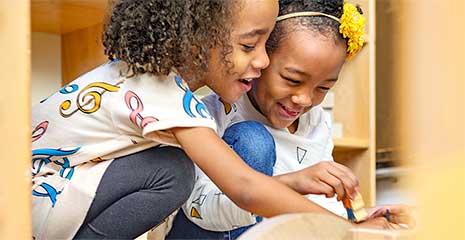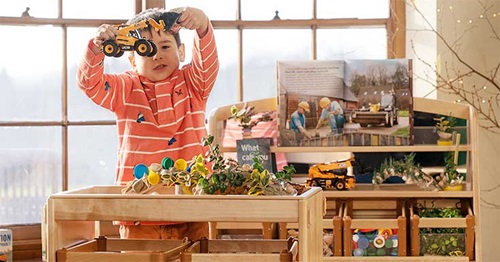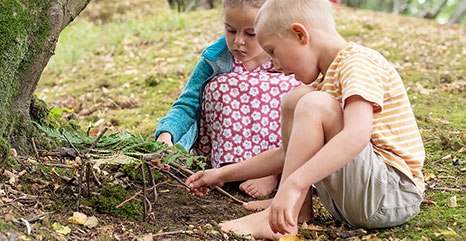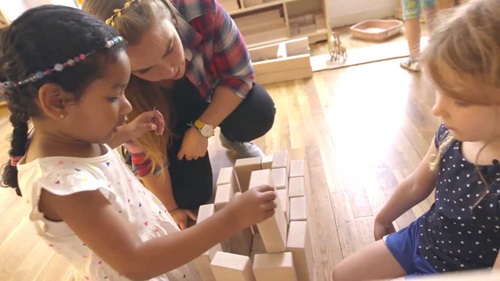Setting up the block area
| June 2011Almost all children enjoy playing in the block area and can find something to do with blocks, whether or not they have ever played with them before. Young children with little prior experience enjoy taking blocks off the shelves, heaping them into piles, lining them up, stacking them, loading them into cartons, dumping them out, carrying them, and fitting them carefully back on the shelves. After they have had plenty of time to explore blocks, children begin to build all kinds of structures. With increasing thoughtfulness, they begin to experiment with balance, enclosure, patterns, and symmetry. They also combine blocks with little people, animals, and vehicles in make-believe play. Structures become houses and barns; lined-up blocks become roads and fences. As children play on their own and with others, adults recognise and support their exploration, imitation, spatial problem solving, sorting, comparing, and pretending.
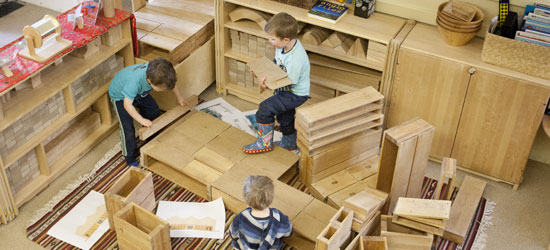
Space for quiet and vigorous block play
Many children play very vigorously in the block area, taking up lots of space. A road race may extend from one end of the block area to the other, for example, and hospital play may involve numerous patients, hospital staff, and beds. Such highly social play is normal and important. At the same time, other children play very quietly with blocks, exploring and arranging them by themselves in their own space. This quiet, solitary block play is equally valid and necessary. Since the vigorous, more social block players often take over the space they need at the expense of the quiet block players, it is important to provide space for both kinds of play. Here are some strategies to consider:
- Enclose part of the block area to create a nook for quiet block play.
- Take blocks outside where there is more space for both quiet and vigorous block play.
- Help quiet block players find a spot outside the block area where they can take their blocks and play undisturbed – for example, under a table, in a tent, inside a large box.
Location
Because of its popularity, the block area works best when located in a spacious area. Setting up the area so it opens onto a central space allows block play to extend outward on particularly busy days. Locating the block area away from the area for wheeled toys and the general traffic flow allows children to balance their structures undisturbed and keeps accidental topplings to a minimum.
Since role play often extends from the house area to the block area, locating the block area next to or across from the house area allows children to use both areas simultaneously without disrupting children working in other areas. In the house area, blocks become beds, walls, telephones, dishes, and cars, while pots and pans, tablecloths, mirrors, and dolls add realistic details to the structures children build in the block area.
If your block area is small, try one or more of the following strategies to make it more spacious:
- Eliminate extra furniture (adult-sized desks, file cabinets, unused tables, storage cabinets).
- Use hallways for coats, cubbies, and extra storage.
- Move blocks and building materials outside.
Low shelves and storage containers can create boundaries in the block area. A flat, tightly woven carpet helps to define the area, reduces noise, and provides a comfortable work surface.
Materials
Block area materials include all kinds of things to build with, put together and take apart, fill and empty, and pretend with. When space permits, the block area also includes materials children can test their strength against, such as logs, tree-stump rounds, and a real gate. Since the block area has wide appeal and a number of children often plan to play there at the same time, it is important to have plenty of materials. This often means supplementing commercially made blocks with homemade and found building materials.
Accessible storage
Big heavy blocks, large boxes, boards, carpet pieces, wooden vehicles, and large Tinkertoys can be stored on the floor in clearly labelled containers or spaces. Before you begin labelling block area materials, look at how you have arranged them and decide which materials will work best with individual labels, and which with group labels. For example, you might put all the small, multicoloured blocks in a basket or tub labelled with a picture, photograph, or one or two of the blocks themselves. You might store the unit blocks by size, with one label for all the square blocks, one for all the rectangles, and so forth. You might put all the medium-sized cars on one shelf, all the trucks on another, and all the little metal cars in a tub.
Block area materials
Building materials
Large hollow blocks, ramps, boards, unit blocks (as many shapes and sizes as possible), small blocks (multicoloured and/or plain), cardboard blocks, blocks made from boxes or milk cartons, covered with cloth or contact-paper, pieces of carpet, cardboard, Plexiglass, Styrofoam, Sheets, blankets, tarps, tents, packing boxes, Boards, sticks, logs, tree-stump rounds and stumps, cardboard, metal, or plastic tubes, rope and pulleys
Take-apart-and-put-together materials
Wooden or plastic “take-apart” trucks and cars (some that snap, some that screw), Large Tinkertoys Interlocking blocks and boards, Clip-on wheels and blocks, interlocking train tracks, plastic plumbing pipes and connectors
Fill-and-empty materials
Dump trucks, pickup trucks, boxes, cartons, baskets, cans, buckets, crates, picnic baskets, small blocks, small vehicles, people, animals, dollhouse furniture, empty sewing spools, stones, pea gravel
Pretend-play materials
Cars and trucks (scaled to blocks), Construction and farm vehicles, planes, helicopters, boats, trains, buses, multiracial dollhouse people, dollhouse furniture, wooden, rubber, or plastic animals familiar to children, steering wheel
Reference photos
Photographs of children’s homes, neighbourhoods, farms, photographs and drawings of children’s block structures

